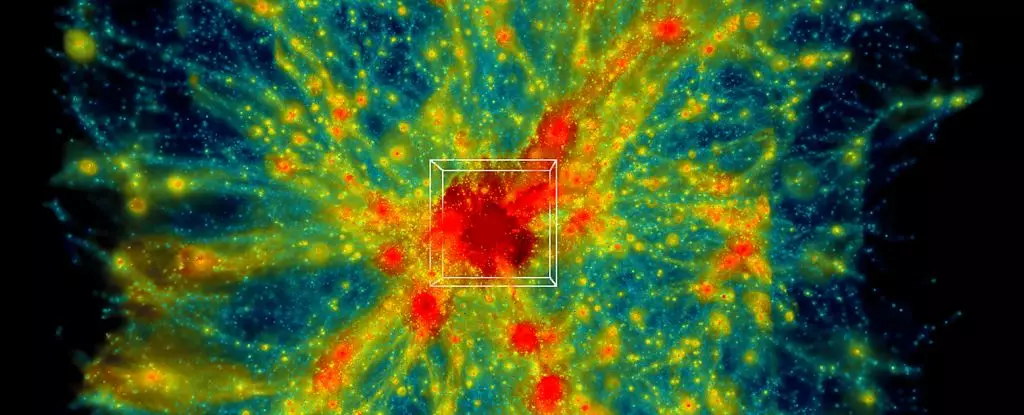In a remarkable leap for astrophysics, researchers at Oak Ridge National Laboratory have harnessed the power of supercomputing to conduct the largest astrophysical simulation ever executed. This ambitious undertaking, named ExaSky, was facilitated through the use of 9,000 computing nodes comprising the Frontier supercomputer. In November 2024, the researchers simulated an astonishing volume of the Universe that spans over 31 billion cubic megaparsecs. The implications of this achievement are profound, as it promises to deepen our understanding of cosmic evolution and the enigmatic nature of dark matter.
Understanding the Universe’s composition involves grappling with two fundamental elements: dark matter, which interacts primarily through gravity, and conventional matter, or atomic matter, which we encounter in our daily lives. Physicist Salman Habib, who spearheaded the ExaSky initiative, emphasizes that a complete simulation of cosmic phenomena must encompass both of these components. The intricate interplay of these factors necessitates sophisticated models that account for not only gravitational dynamics but also additional physical phenomena, such as the behavior of hot gas, the formation of stars, and the emergence of galaxies and black holes.
To visualize the Universe’s vastness, we can think of it as a sprawling stage upon which time and space unfold over billions of years. However, monitoring these changes in real-time is impractical due to the immense timescales involved. Thus, simulations become a pivotal tool for astrophysicists, allowing them to explore cosmic evolution by adjusting parameters, altering time, and zooming in on different spatial dimensions. This complex task, while seemingly straightforward, requires advanced mathematical frameworks and powerful computational resources.
While advancements in computing have led to unprecedented simulations, previous models often had to compromise on certain variables to enhance efficiency. According to Habib, this meant that earlier attempts to simulate large portions of the Universe, especially when equipped with observational data from major telescopes like the Rubin Observatory in Chile, were limited to gravity-only approximations. The nuances and intricate processes that govern cosmic behavior often went overlooked.
One of the considerable hurdles facing researchers in this field is the necessity of refining algorithms and mathematical methodologies to improve simulation accuracy. The Hardware/Hybrid Accelerated Cosmology Code that powers ExaSky underwent significant enhancements, facilitating the simulation of more complex cosmic interactions. By integrating different physical processes, scientists can now create a more holistic view of the Universe’s behavior, ultimately yielding insights into phenomena that were previously beyond reach.
The Significance of Frontier Supercomputing
With the advent of the Frontier supercomputer, which was the fastest in the world at the time, the researchers gained access to a computational power previously unimaginable. This newfound capability allowed them to expand the scope of their simulations and explore the Universe’s expansion in greater detail. Notably, the ExaSky project represents a mere 0.001 percent of the total volume being simulated, indicating that researchers anticipate uncovering results that could reshape our understanding of the cosmos.
Astrophysicist Bronson Messer notes that this exploration is vital for correlating the simulation outcomes with contemporary survey observations enabled by exascale computing. By juxtaposing simulated data with real-world observations, the astrophysics community stands to gain a vastly improved comprehension of cosmic phenomena, potentially shedding light on longstanding mysteries, such as the fundamental makeup of dark matter and the exact nature of cosmic evolution.
As the ExaSky simulations continue to progress, the scientific community is poised for a paradigm shift in our comprehension of the Universe. The integration of enhanced computational power and sophisticated algorithms promises to unlock unprecedented details about the cosmic tapestry. By safely navigating through the cosmic timeframes and dimensions, physicists can explore the underlying mechanics that have shaped our Universe since its inception.
The ExaSky project at Oak Ridge National Laboratory stands at the forefront of astrophysical research, demonstrating the profound impact of supercomputing on our understanding of the cosmos. As researchers delve deeper into the complexities of the Universe, they inch closer to unraveling the mysteries that lie beyond the stars, promising exciting revelations in the exploration of dark matter and the very fabric of existence.


Leave a Reply